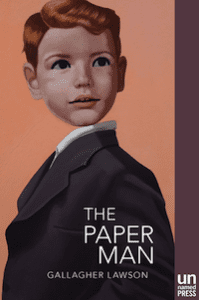
In Anatomy of Criticism, the Canadian literary critic Northrop Frye explains that an essential difference between two forms of fiction, the romance and the novel, is their development of characters. In the romance, we find stylized figures rather than the naturalistic characters of novels with their social personae. Frye describes the hero of a romance as one who is identified as a human, but who moves in a world in which the ordinary laws of nature are “slightly suspended.” Much of prose fiction, Frye points out, is mixed, using combinations of four types: novel, romance, anatomy and confession.
Taxonomy is important for how we read the dark, strange extended fable The Paper Man by Gallagher Lawson. It is a combination of romance and novel, strongly slanted, at first, toward romance. A young artistic hero named Michael runs away from his sheltered home inland, and takes a bus to a city by the ocean. Michael began life as a normal man, one of several brothers, but after an accident, the particulars of which remain a mystery, he is rebuilt as a paper man by his father. He lives on shredded paper and milk soups and learns bookkeeping, which his father believes will help him fit into his new paper body.
From the beginning, Michael’s materiality and paper-ness present dramatic obstacles. His bus crashes because a dead mermaid is lying in the road, and he winds up caught in a rainstorm, where he begins to disintegrate. He gets an ugly dent in his paper face and despairs. A young woman, Maiko, rescues him, takes him into her musty mushroom-scented apartment, and rebuilds his paper mask. Although she seems like a romantic interest of sorts, he is still in love with Mischa, a girl from high school with whom he read poetry before his accident, who boarded a train and left their hometown.
At first we don’t receive a clear picture of Maiko as an individual—she is simply the first of Michael’s several rescuers, a woman who puts him back together, fashioning his new papier-mâché cast and repainting his face. She helps him survive in the city and makes shredded paper soups for him at night. They shop at the fish market together. But as a stylized romantic figure, her role in the drama, particularly toward the end of the book, is memorable.
Much of the power of The Paper Man arises from small observations about living inside a mask, inside a constructed body that often falls apart and prevents Michael from sharing intimate moments. Lawson never forgets his central conceit. In one scene, Maiko helps Michael put on his new mask in the dark of her bedroom after he tells her the story of Mischa.
He panicked at first and thought he was suffocating. He reached to pull it away, but the string was too tight. He felt Maiko pull his hands away then stroke the cheek of the mask. It was so distant—in fact, he didn’t really experience the touch at all, only heard the dry fingers stroke the dry paper mask. Then he realized he couldn’t see properly out of the eye holes. He turned to her.
“Let me adjust it a bit. Hold still.”
Okay, he said. His voice sounded muffled behind the mask. As if it filtered the tone of his voice to become the voice of someone else.

The city to which Michael has escaped is falling apart, sinker deeper into anarchy by story’s end, riven by power struggles. The terms of these struggles are only mildly suggestive of contemporary society; they have a quaint, fantastical quality. A northern power threatens to invade and annex the city because of its natural harbor, beaches and fish market. A radio broadcaster rants about the immigrants, including mermaids that are causing the city harm. Maiko and Michael hang signs protesting annexation by the north.
Michael gets a job as a bookkeeper for a tuna cannery, and must work aboard a ship—a challenge for a paper man working in steam and condensation. The man who interviews him for the job guesses that Michael wears the mask because he’s ugly and notes that city-dwellers are becoming paranoid about who’s watching them due to the political tensions. After getting attacked by a mob because he is an outsider, Michael is rescued by a gallery owner who invites him into his art gallery to be fixed.
This is where the story really takes off. Michael wanders about the gallery, looking at paintings. The final painting he sees is of Mischa. Michael finagles a meeting with the slightly villainous artist who painted the portrait, David Doppelman, in hopes of being reunited with Mischa. In his mind, their reunion as a romantic one, particularly since he has grown weary of Maiko’s ministrations. But Mischa proves to be cruel and strange, a far cry from Michael’s romantic vision of her. Her destructive actions lead to changes in Michael, and eventually, changes in the city.
In trying to create an uncanny atmosphere for the work, the first fifty or so pages of Lawson’s book take a number of risks with metaphors. Some of these risks result in unusual beauty, but others feel like missteps into the purple. Michael observes “liquid shadows on the bus that quickly spread in empty seats like sprouting fungi” and later, while trying on Maiko’s fur mantle “the fur quickly slipped off the table when he sat up, as if, once released, it was trying to escape from him.” Odd, too, is the author’s choice to vary the use of quotation marks around Michael’s speech from section to section. At first I thought the loss of quotation marks signified the paper man becoming less real and then more real, but by the end of the book I was uncertain about the meaning of the shifts. As the fable progresses, the language evens out, becoming more transparent and cinematic.
In the book’s subtle allusiveness you can catch glimpses of the Wizard of Oz, Star Wars, David Lynch films, Miyazaki’s anime fairytales, The Velveteen Rabbit, Eyes Wide Shut, and Jose Saramago’s fables. No one influence predominates. Days after reading it, certain deeply weird scenes, erotic scenes and destructive scenes featuring paper, are still playing in my mind, still worming through my subconscious, like a waking dream.
The Paper Man is an interesting contribution to a rising American literary genre that combines the fantastic with emotional realism. Unlike other novelists working in this mode (Aimee Bender, Ramona Ausubel, Karen Russell), for whom the feelings and beliefs of human characters remain relevant in spite of certain fantastic elements, Lawson seems to be working in the more introverted and subjective manner of Frye’s romances. Michael’s internal, idiosyncratic hero’s journey eventually takes on a sinister cast as he brings social change to a world that bears only a mild resemblance to ours.
The Paper Man purports to be an allegory, but I never quite pinpointed its underlying meaning. Is it an allegory of power? Art? Rebirth? Social acceptance? Perhaps all these things. With its essential mysteriousness, the book is a haunting debut, a children’s fable for adults that palpably captures what it might mean to hide behind a paper mask, and a social persona as well.




